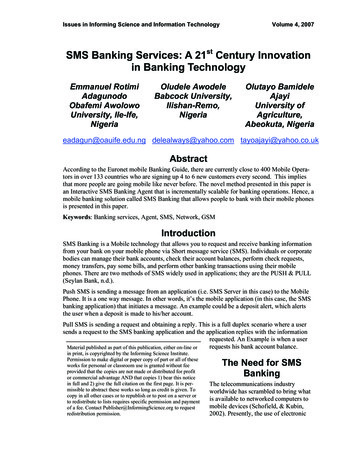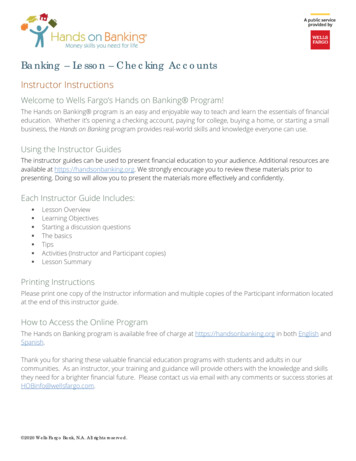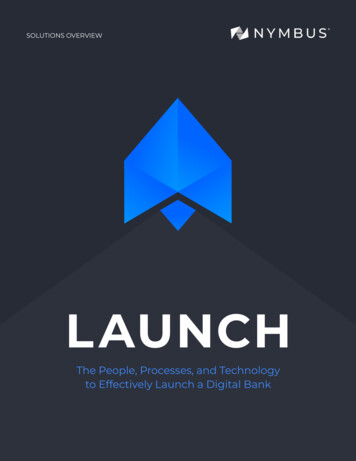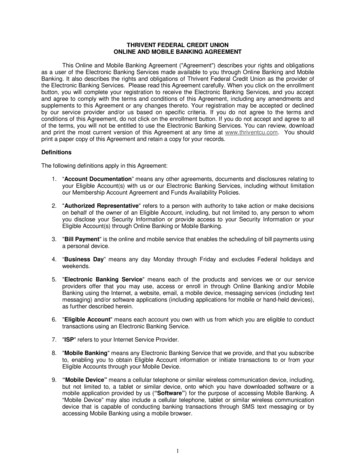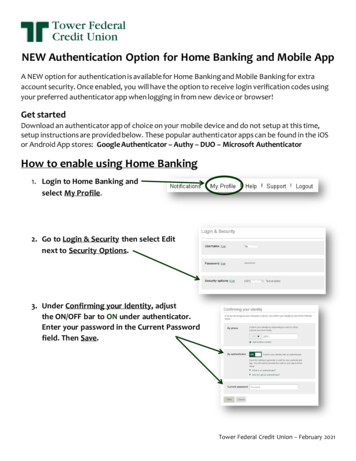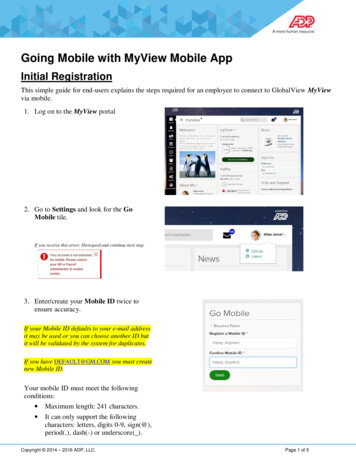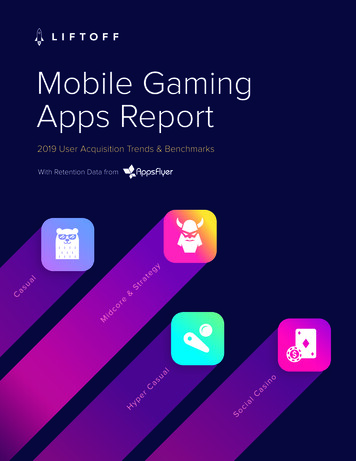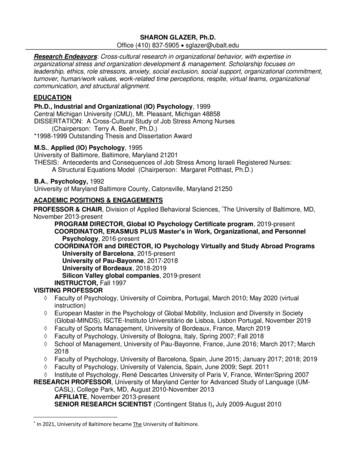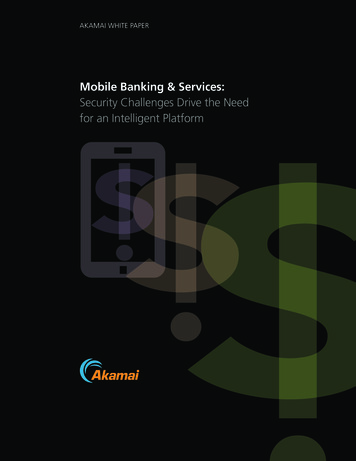
Transcription
AKAMAI WHITE PAPERMobile Banking & Services:Security Challenges Drive the Needfor an Intelligent Platform
Table of ContentsINTRODUCTION . . . . . . . . . . . . . . . . . . . . . . . . . . . . . . . . . . . . . . . . . . . . . . . . . . . . . . . . . . . .1CURRENT STATE OF MOBILITY. . . . . . . . . . . . . . . . . . . . . . . . . . . . . . . . . . . . . . . . . . . . . . . .1RISING SECURITY CONCERNS . . . . . . . . . . . . . . . . . . . . . . . . . . . . . . . . . . . . . . . . . . . . . . . .2THE NEED TO ENHANCE MOBILE SECURITY, MOBILE OFFERINGS . . . . . . . . . . . . . . . . . . 3KEY TO MOBILE SECURITY: AN INTELLIGENT PLATFORM . . . . . . . . . . . . . . . . . . . . . . . . . 5CONCLUSION . . . . . . . . . . . . . . . . . . . . . . . . . . . . . . . . . . . . . . . . . . . . . . . . . . . . . . . . . . . . . 5
Mobile Banking & Services: Security Challenges Drive the Need for an Intelligent PlatformIntroductionTo stay competitive, financial services organizations must offer mobile access to theirproducts and services, but security is an issue that still looms large for both theinstitutions and their end customers. On one hand, financial services firms point toimproved customer services, retention of current customers, and acquiring moremillennial customers as the key objectives of their mobile strategies, but on the otherhand cite data theft, damaged reputation, and noncompliance as significant risks.Banks and financial firms also recognize that customers have security concerns, andworry about the misuse of their personal data, yet at the same time they arefrustrated by the limited usefulness of some current mobile offerings.Going forward, financial services organizations will need to both bolster their mobilesecurity postures to assuage customers’ concerns, while enhancing their mobileofferings to satisfy customer demand. It will require building their mobile strategiesaround an intelligent platform to safeguard data, stop the largest Distributed Denialof Service (DDoS) and other cyberattacks, prevent downtime, and have theintelligence to adapt to the evolving threat landscape — all without impactingperformance for customers.To get a pulse on the current state of mobile and security strategies, Gatepoint Research surveyed130 selected financial industry executives between July and November 2016. Respondents arepredominantly senior decision makers: CxOs (21%), VPs (30%), directors (27%), and managers(17%).Respondents work for firms with a wide range of revenue levels: 22% work in Fortune 1000 companies with revenues of more than 1.5 billion. 17% work in large firms (revenues between 500 million and 1.5 billion). 8% work in midmarket firms (250 million to 500 million in revenues). 53% work in small companies (less than 250 million in revenues).Current State of MobilityThere is no denying the tsunami of the smartphone, and the push from end customers andemployees to conduct both personal and professional tasks from their devices. According to thePew Research Center survey conducted in November 2016, 77% of Americans own a smartphone,a percentage that has more than doubled since 2011. Among young adults, smartphone ownershipis at 92%, while the use of smartphones by Americans ages 50–64 has climbed to 74%, accordingto Pew.No surprise, then, that mobile banking is on the rise. According to the Federal Reserve’s report,Consumers and Mobile Financial Services 2016, 43% of all mobile phone owners with a bankaccount had used mobile banking in the 12 months prior to the survey, up from 39% in 2014;and 53% of smartphone owners with a bank account had used mobile banking in the 12 monthsprior to the survey, up from 52% a year earlier.1
Mobile Banking & Services: Security Challenges Drive the Need for an Intelligent Platform2Banking is one of the top three commercial industries projected to make the largest mobilityinvestments in 2017, according to market research firm IDC, which also projects that totalworldwide mobility spending will hit 1.57 trillion this year with steady growth through 2020.According to the Gatepoint survey, the leading objectives driving respondents’ mobile efforts are toimprove customer service (77%), retain customers (63%), and acquire more millennials (42%). Andthe prevailing mobile strategy is to have a native app solution (39%) or a mobile app website (32%).But respondents are feeling the pressure to stay competitive with their mobile strategies: Well overhalf—61%—consider their mobile capabilities to be, to some degree, behind their competitors’.77%LEADING IMPROVEOBJECTIVES: TRATEGIES:39%NATIVE APPSOLUTION61% RANK THEIR MOBILE CAPABILITIES AS LAGGING BEHIND THEIR PEERS!Rising Security ConcernsWhile mobile technology is the way forward, security concerns are not trivial. A January 2017 reportfrom Pew Research shows that 64% of U.S. adults have been impacted by data theft. Notably, 41%of Americans have encountered fraudulent charges on their credit cards, and 35% have receivednotices that some type of sensitive information (like an account number) had been compromised.Also, 14% say that someone has attempted to take out loans or lines of credit in their name.In its Consumers and Mobile Financial Services 2016 report, the Federal Reserve notes that concernabout the security of the technology is a common reason for not using mobile banking (73%) ormobile payments (67%).MOBILE STRATEGIESMUST ADDRESS CLIENTS’TOP CONCERNS AND THE MOSTSIGNIFICANT RISKS OFCYBER ATTACKSMISUSE OF THEIRPERSONAL INFORMATIONDAMAGEDREPUTATIONDELIBERATE THEFT(OR LOSS) OF DATADATATHEFTIn line with these concerns, Gatepoint’s research finds that respondents rank security (80%) andprivacy (76%) most often as “extremely important” factors in the adoption of mobile banking. Andamong the cyberattack risks they find most significant, 79% of respondents cite data theft, followedby damaged reputation (68%).32%MOBILE APPWEB SITE
Mobile Banking & Services: Security Challenges Drive the Need for an Intelligent Platform3IMPORTANT FACTORS IN THE ADOPTION OF MOBILE ELIABILITYBARRIERS TO ADOPTION:48%SECURITY43%LIMITED USEFULNESS OF MOBILE41%LACK OF TRUSTIN TECHNOLOGYEND CUSTOMERS ARE WORRIED ABOUT MOBILE SECURITY TOO!These financial institutions know their customers have concerns too. Gatepoint respondents reportthe leading barrier to end user adoption is security (48%). Also, 43% of respondents cite the limitedusefulness of mobile technology, with 41% saying a lack of trust in the technology is also a barrier.Finally, respondents believe their clients are concerned in nearly equal measures about misuse of theirpersonal information (73%), and theft / loss of data via lost, stolen, or hacked phones (71%).The Need to Enhance Mobile Security, Mobile OfferingsBanks and other financial institutions need to continue enhancing and innovating with their mobileofferings to stay competitive, while putting in place a mobile security strategy that will protect anddefend against cyberthreats without impacting performance. Asked how they are handling websecurity monitoring and remediation today, the vast majority (80%) of respondents to Gatepoint’ssurvey say they are utilizing external service providers, and 58% are using a combination of externalservice providers and in-house defenses. Only 14% depend on an in-house-developed solution.The survey also explores organizational barriers that might be standing in the way of investing innew web security and mobile solutions / services. The top barrier is perceived risk vs. cost, cited by48% of respondents, followed by staffing shortfalls at 45%.HOW WEB SECURITY IS HANDLED ALSERVICEPROVIDERSAND IN-HOUSEDEFENSESHIGHEST BARRIERS AGAINST UPGRADINGWEB SECURITY AND MOBILE SERVICES:48%PERCEIVED RISKVS. COSTYet despite these obstacles, respondents’ top priorities for the next 12 months are virtually tiedbetween ensuring and establishing cybersecurity and achieving and adhering to regulatorycompliance.HIGHEST PRIORITIESFOR THE COMING YEAR:CYBERSECURITYREGULATORY COMPLIANCE45%STAFFINGSHORTFALLS
Mobile Banking & Services: Security Challenges Drive the Need for an Intelligent PlatformKey to Mobile Security: An Intelligent PlatformTo meet customer demand for instant, secure, reliable online access to all content and services—onany device, anywhere—banking, insurance, asset management, brokerage, payments, and financialexchanges need an intelligent platform and a trusted provider to help safeguard websites and otherInternet-facing applications from the risks of downtime and data theft. That’s why top companies—including 100 of the world’s leading banks—rely on and trust the Akamai Intelligent Platform .Built on the Akamai Intelligent Platform, Akamai Cloud Security Solutions provide the scale to stopDDoS and web application attacks without reducing performance, as well as intelligence into thelatest threats and the expertise to adapt to shifting tactics and attack vectors. With more than220,000 servers deployed around the world, Akamai can maintain connectivity through the mostadverse conditions—including the largest DDoS attacks.Also built on the platform is Akamai Ion, a suite of integrated performance optimizations, tools,and intelligence that together address each stage of delivering compelling online experiences forcustomers.ConclusionMobile security concerns are keeping financial institutions up at night. Indeed, 63% of Gatepointsurvey respondents say security issues are the leading cause of insomnia. The Akamai IntelligentPlatform comprising Akamai Cloud Security Solutions and the Ion optimization suite can help themsleep better—and become more competitive and compelling—in the mobile world.The Akamai Intelligent Platform Improves site performance to delight customers and grow revenue Defends against attacks and data breaches Leverages the cloud to realize cost savings and global reachTo learn more about Akamai’s financial services solutions, visit Akamai.Explore how Akamai can protect your mobile banking customers by viewing the webinar“Mobile Banking and the Digital Experience: How to Protect Your Customers.”For a free trial of Ion, click here.As the global leader in Content Delivery Network (CDN) services, Akamai makes the Internet fast, reliable and secure for its customers. The company’s advanced webperformance, mobile performance, cloud security and media delivery solutions are revolutionizing how businesses optimize consumer, enterprise and entertainmentexperiences for any device, anywhere. To learn how Akamai solutions and its team of Internet experts are helping businesses move faster forward, please visitwww.akamai.com or blogs.akamai.com, and follow @Akamai on Twitter.Akamai is headquartered in Cambridge, Massachusetts in the United States with operations in more than 57 offices around the world. Our services and renownedcustomer care are designed to enable businesses to provide an unparalleled Internet experience for their customers worldwide. Addresses, phone numbers, andcontact information for all locations are listed on www.akamai.com/locations. 2017 Akamai Technologies, Inc. All Rights Reserved. Reproduction in whole or in part in any form or medium without express written permission is prohibited.Akamai and the Akamai wave logo are registered trademarks. Other trademarks contained herein are the property of their respective owners. Akamai believes thatthe information in this publication is accurate as of its publication date; such information is subject to change without notice. Published 04/17.4
Built on the Akamai Intelligent Platform, Akamai Cloud Security Solutions provide the scale to stop DDoS and web application attacks without reducing performance, as well as intelligence into the latest threats and the expertise to adapt to shifting tactics and attack vectors. With more than 220,000 servers d

